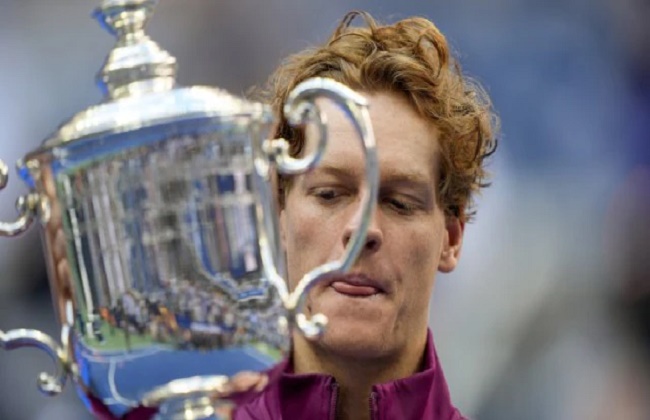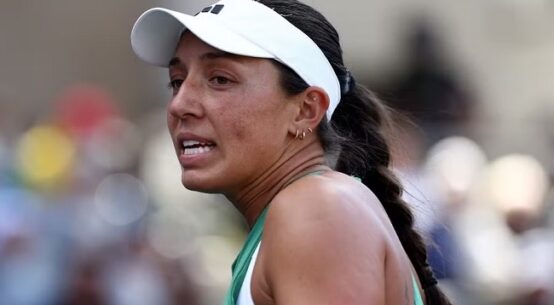
Take a peek at Monday’s US Open final, and one finds that Jannik Sinner is an elegant shotmaker. Don’t be fooled by his mild manner or wiry frame, the purity with which the Italian strikes the ball, and the strength of his athleticism make for a lethal combination. He can unfurl unplayable forehand strokes, and in the same motion, pirouette into a defensive backhand slice.
Go through Sinner’s journey behind his US Open triumph, and one finds that beneath the silk, lies a layer of steel too.
In a final that was less of a contest and more of a procession, Sinner cantered to a second Grand Slam title by outplaying and outthinking the 12th seeded Taylor Fritz 6-3, 6-4, 7-5 that further underlined his status as the the No. 1 player in the world.
The day that Sinner marked himself as the favourite for this US Open title was also the day that a permanent mark on his back appeared. After winning the Cincinnati Masters in the buildup to the season-ending Major, it was revealed that Sinner had tested positive for traces of a banned substance, Clostebol, in March. After successfully appealing temporary suspensions, Sinner was eventually cleared by an independent tribunal who concluded that he bore no fault or negligence due to accidental contaminations.
There was cynicism about it though. Locker room peers complained of preferential treatment, doubts swirled over why the entire process took place out of public view, the mistrust of the players with the governing bodies was laid bare, and Sinner, at the centre of it all, was forced to feel its wrath.
Yet, the 23-year-old Italian dealt with all of it remarkably straightforwardly. He fronted up and had his side of the story clear. He sacked the two members of his team that were responsible for the transdermal contamination. He continued to win despite being weighed down by the massive off-court controversy and a persistent hip problem – even when his two main rivals for the title, Carlos Alcaraz and Novak Djokovic, crashed out early.
Ultimately, Sinner blocked out the noise and cruised to the US Open like the best players in the world often do – without much of a fuss. He later revealed how this latest period of his career has taken a toll. “I understood, especially in this tournament, how important the mental part is in this sport,” he said after the final, per Reuters. “With my family and team and everyone who supports me daily, I always try to stick together with them especially when moments are getting difficult and tough… It was and still is a little bit in my mind. It’s not that it’s gone. But when I’m on court I try to focus on the game and try to handle the situation in the best possible way.”
Monday’s final was, in a microcosm, how his entire tournament went – Sinner did not hit top gear, and did not need to.
Play opened with Fritz under pressure of playing his first Major final in front of an expectant home crowd. His serve evaded him and his flat forehand did not have the same punch, Sinner cruised through first set despite hitting only seven winners compared to eight unforced errors.
In the second, Sinner further went into lockdown mode. The fact that he was not at his best and still dominant showed his consistency from the baseline, his steadiness in rallies, and the depth of his groundstrokes. He was too complete, and too powerful, for Fritz to contend. Sinner won every single one of the 14 points behind his first serve, put pressure on Fritz’s second, and only needed one break point – in the final game of the set – to leave with a two-set cushion.
At the back end of the third, there was a mini recovery. Fritz went up a break and the home crowd – desperate for a first American Grand Slam champion since Andy Roddick in 2003 – lifted Fritz’s level from somewhere near the floor to somewhere closer to his ceiling. Sinner responded with remarkable nonchalance, merely going up another gear to win four games in a row and wrap up the straight sets victory.
Later, Fritz admitted that he was far from his best on the day. He will have to wait for another opportunity to prove whether or not the best level of his big-serving, flat-hitting game will be enough to contend with Sinner’s all-court excellence on a stage like this. If he continues to play the way he did on Monday, he is unlikely to get that chance.
Sinner, meanwhile, put a Grand Slam bow on one of the best ATP seasons since Novak Djokovic in 2015 despite the potential doping ban hanging over his head. He became the first Italian man to win the US Open, the first man since Guillermo Villas in 1977 to win his first two shingles Majors in the same year, and just the fourth man to win both hard court Majors in the same year.
The Italian was rewarded with another Major for his incredible consistency. He has extended his lead as the World No. 1 to over 4,000 points. His win percentage on tour now stands at a whopping 91.66% (55 wins, 5 losses) in 2024. He has lost only two hard court matches all year.
It is success on the big stage, and not consistency, that often marks the best players in the world though. And that is where Carlos Alcaraz had surged ahead after his French Open and Wimbledon double. Sinner’s victory underlines that he too has the mettle to succeed on these stages, and with both players sweeping the Slams in 2024, it also means that the younger generation has officially leapfrogged the one above it.
Between the two of them, players born in the 2000s have now won all six of the Major finals they have played, while players born in the 1990s – the original ‘Next Gen’ of which Fritz is very much a part – have only won two in 19 attempts.
But most importantly, Sinner proved that no matter what storm is raging around him, he is capable of taking care of business without much of a bother. As the doubts continue to do the rounds over his doping violation, and the conspiracies continue to float, he can take solace in the fact that it will not stop him from winning.


